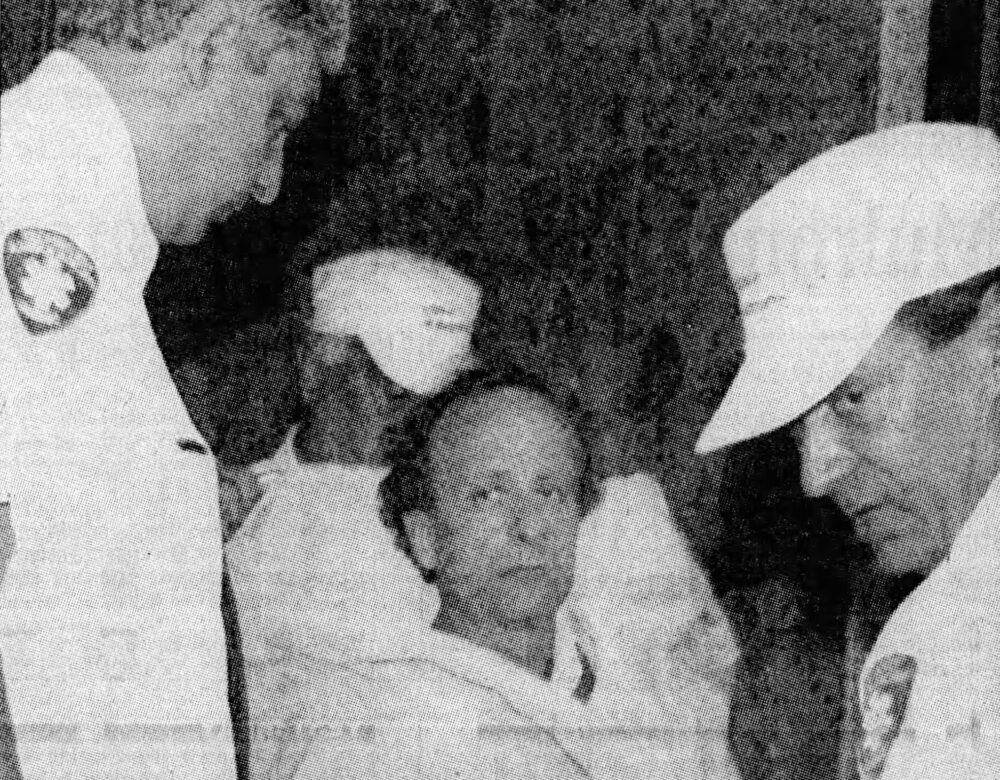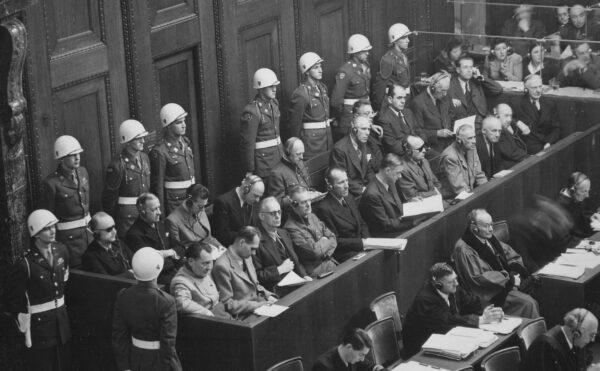A mechanical engineer named Valery Fabrikant acted aggressively toward his colleagues for years, and after many warning signs, he murdered four of his colleagues. Now spending time behind prison bars, he still publishes scientific papers.
About The Disappearing Spoon
Hosted by New York Times best-selling author Sam Kean, The Disappearing Spoon tells little-known stories from our scientific past—from the shocking way the smallpox vaccine was transported around the world to why we don’t have a birth control pill for men. These topsy-turvy science tales, some of which have never made it into history books, are surprisingly powerful and insightful.
Credits
Host: Sam Kean
Senior Producer: Mariel Carr
Producer: Rigoberto Hernandez
Associate Producer: Sarah Kaplan
Audio Engineering: Rowhome Productions
Transcript
Imagine you’re a scientist in the 1990s. You’re flipping through a research journal, and a paper catches your eye. It’s about how cracks form and spread in concrete. You start skimming it—then slow down and start reading in earnest.
It’s great stuff—really insightful. Concrete is a common building material, especially in the developing world. When cracks form in concrete, those structures can collapse and kill people. But work like this could improve structure, and potentially save lives. Your eyes jump to the top of the page, curious who wrote this.
That’s when you freeze. There’s a name listed there, Valery Fabrikant. But instead of a job title like professor, Fabrikant identifies himself as prisoner #167932-D. His home institution is listed as a prison outside Montreal.
Valery Fabrikant shot four colleagues in Montreal in cold blood after failing to get tenure.
And maybe you’re left thinking, why would a journal publish this paper? Shouldn’t committing murder bar you from the scientific community?
But according to many scientists, no. In fact, they argue that Fabrikant’s story goes to the heart of what science is; what it stands for; and why its morals are so different than the rest of society’s.
In December 1979, Valery Fabrikant showed up at the mechanical engineering department at Concordia University in Montreal. He was 39 years old, a short, slight man with greying hair and glasses. He claimed to be a political dissident from the Soviet Union seeking asylum. He begged the department chair for a job. The chair took a chance and hired him.
Which soon made the department chair look like a genius. Fabrikant quickly won grants from places like NASA, and he published an amazing 25 papers in his first four years. Mostly on how materials respond to mechanical stress. Fabrikant was always boasting about how brilliant he was, and based on his track record, there was some truth to this.
But to anyone paying attention, there were some troubling things going on. Fabrikant kept slapping the department chairman’s name on all his papers as a co-author—even though the chairman hadn’t contributed anything to the research. It seemed like Fabrikant was just kissing ass—or bribing him. Regardless, it paid off. The chairman promoted Fabrikant several times in succession, and Fabrikant’s salary jumped fourfold in four years, from $7,000 to $30,000.
Meanwhile, another, uglier side of Fabrikant was emerging—the nasty, vindictive bully. If someone criticized his work, he’d scream at them. He once flew across the country to a conference simply to yell at a professor at a different school who’d denied him a job there.
Another time, he ordered a laser printer that cost $8600. $8600—in the 1980s! And when it arrived, Fabrikant refused to pay for it, because it came a few days late. Then he got so belligerent with the supplier that the company cut off Concordia’s credit.
Fabrikant also had a wildly inflated sense of his importance. After his father died back in the Soviet Union, the government there owed him a few thousand dollars for a pension. Not surprisingly, the creaky, bankrupt Soviet bureaucracy dragged the matter out for months.
So a furious Fabrikant wrote letters to the Canadian government. Until the pension was resolved, he said, the Canadian government should halt all relief shipments of grain to starving Soviet peasants. Apparently in Fabrikant’s mind, his pension and international famines were matters of equal importance.
But hey, Fabrikant was publishing lots of papers—good papers. And he was putting the department chairman’s name on them. So his department didn’t punish him. In fact, after the printer fiasco, he got another raise, to $46,000.
By the late 1980s, a new department chair had taken over. Around the same time, three tenure-track jobs opened up at Concordia. Fabrikant begged the new chair for one of them. If he did not get it, he said he’d solve things “the American way.” Then he mimed shooting a gun with his fingers.
In response, the chairman more or less laughed. That was just Valery being Valery. He was eccentric, a hothead. The important thing was his stellar publication record. So he got one of the jobs.
Scarily, this threat was not an isolated incident. He later told one department secretary that, “the only way to get what you want in North America is to … shoot a lot of people.” In fact, he harassed so many secretaries around campus that a few had panic buttons installed beneath their desks. That way, they could summon security if he got belligerent. Despite this, in 1990, he got another raise, to $60,000.
Still, by 1990, some of Fabrikant’s colleagues had grown weary of his tirades, threats, and harassment. They began holding secret meetings, discussing how to get rid of him.
Meanwhile, a vice-rector at Concordia consulted an expert on workplace violence. The expert warned her that Fabrikant posed a serious danger. The vice-rector in turn told her boss, the actual rector. But the rector shrugged. Professors were eccentric. What could he do?
Somehow Fabrikant caught wind of these discussions, which he took as plots against him. In response, he showed up at a faculty senate meeting with a huge portfolio envelope. It looked like something to conceal a weapon inside. Someone called the police, who detained and searched Fabrikant. But there was no gun inside the envelope. He’d been trolling everyone, and now he could accuse them of paranoia as well.
Things came to a head in 1992. A block within Fabrikant’s department began working with university administrators, trying to get him fired or to force him to retire early.
In response, Fabrikant went ballistic. He learned how to email and started sending dark messages to people—saying that if he died and it looked like suicide, don’t believe it. He swore Concordia was plotting to murder him.
In reality, Fabrikant was the one plotting murder. One afternoon in August 1992, he rode the elevator to the 9th floor of the mechanical engineering building on campus, where the faculty had offices. He was carrying a leather briefcase.
He stormed into one engineer’s office. In response, the engineer produced a letter. The engineer had actually been looking for Fabrikant that week. He explained that the letter outlined when and under what circumstances Fabrikant was allowed to visit campus offices in the future. The department was not going to take his crap anymore.
Fabrikant responded by opening the briefcase, removing a handgun, and shooting the man four times. He bled to death on the floor of his office, still clutching the letter.
Afterward, Fabrikant stalked down the hall, firing his gun into open offices. He shot four more people, three of whom died.
Another colleague finally wrestled the gun away. Unfortunately, Fabrikant had two more guns in his briefcase. Brandishing one, he took two people hostage into an office.
There he called 9-1-1 and demanded to talk to a TV news station. He admitted he’d killed people. But he wanted to explain to the world how the university had driven him to this—how he’d been persecuted.
He stayed on the phone for an hour. But at some point, he put the gun down to stretch his cramping neck. Bravely, one of the hostages sprang up and kicked the gun away. As Fabrikant lunged for it, the other hostage wrestled him down and pinned him until the police arrived.
Fabrikant was charged with four counts of murder. Seventeen days later, the university rector finally had had enough. He wrote Fabrikant a strongly worded letter. It said, “You are no longer accomplishing your duties as a faculty member.” Then he fired him.
To those who might say, uh, maybe that’s too little, too late, the rector threw up his hands. He blamed gun laws in Canada. Who could ever have seen this coming?
It’s a good question. Because if anyone had done a background check on Fabrikant before hiring him, they would have discovered something telling: Fabrikant hadn’t been kicked out of the Soviet Union for being a political dissident. Instead, he’d burned all his professional bridges there for…guess what? Disruptive and threatening behavior. It would have been good to know that, huh?
True to form, Fabrikant’s trial was a narcissistic circus. He hired and fired ten different lawyers. He finally decided to represent himself, because no one else was smart enough for him.
He called 75 witnesses in his defense. But he got so belligerent—with his own witnesses—that several started crying on the stand. He also called the judge a crook, and was held in contempt of court six times. Fabrikant even had the chutzpah to compare himself to an abused orphan, and said he’d murdered his colleagues in self-defense.
After five nauseating months, the jury found him guilty of four counts of murder and sentenced him to life imprisonment.
But if the world thought they’d heard the last of Valery Fabrikant, they were wrong. He quickly resumed his scientific work in prison. He was convinced that scientists would still be interested in his research. And he was right. Scientists were still interested in Fabrikant’s work—a stance that says a lot about science, and not necessarily something good.
Fabrikant’s story raises obvious questions about gun control and abusive workplace behavior. But I want to focus on something else—the fact that Fabrikant, a convicted murderer, kept writing scientific papers in prison. Should he have been allowed to? And how should scientific journals have handled his submissions?
In prison, Fabrikant had no access to a lab, so he worked on theoretical topics. Like how cracks start and spread in concrete. And when Fabrikant was submitting papers, he didn’t try to hide anything. He listed his address as a prison near Montreal, and included his prisoner ID—#167932-D.
He submitted his first paper from prison in 1994, to The International Journal of Solids and Structure. The editor reviewed it, decided it merited publication, and readied it for the printer.
But word got back to Concordia. The university had fired its old rector, and the new rector was furious at the journal. How could they even consider publishing the work of a murderer? The families of Fabrikant’s victims were outraged as well.
The journal editor admitted he felt torn. Fabrikant had obviously done something heinous. On the other hand, the science checked out. The paper was true. Would the journal be suppressing knowledge by not publishing it?
After some more hand wringing, the editor ultimately published the paper. And he wasn’t alone in doing so. Fabrikant has published 60 papers in 20 different journals since 1996, all from his prison cell. He even has a LinkedIn page.
This has outraged many people. Some have drawn comparisons to Nazis doctors running barbaric medical experiments during World War II. Experiments like deliberately submerging people in ice water to give them hypothermia, then trying to revive them. These critics demanded to know whether the editors who published Fabrikant’s work would also publish research from those monsters?
But, as some people noted, that’s a flawed comparison. The Nazi doctors were committing crimes in the course of their research. They could not have gotten their data without committing the crimes. That wasn’t the case with Fabrikant. His work on concrete and other materials had nothing to do with his crimes. In which case, should he really lose the right to publish?
Some people still said yes. They raised concerns about how manipulative Fabrikant was. Perhaps publishing papers was a sneaky way to impress a parole board and get himself out early. No one would put that past him.
The new rector at Concordia also argued that, in committing his crimes, Fabrikant had violated the rules of society. Science is part of society, and breaking society’s rules should also entail a loss of the right to participate in scientific discourse.
It’s a strong point. Science is not separate from society. But supporting that point puts you in an awkward position.
Consider another group of people who publish things—novelists and journalists. Much like scientists, novelists and journalists are part of society. So should prisoners lose the right to compose books and articles? Surely we don’t want to say that incarcerated people have no right to publish their ideas.
And if prisoners in general retain the right to publish their work, why should a prisoner who happens to be a scientist lose that same right?
Indeed, scientists might have a better claim than other prisoners would. One of the ideals of science is to not take personal factors into account when deciding the merit of a theory. And if you don’t believe me, how about Albert Einstein? As Einstein said, “the essence of a man like myself”—a scientist—“lies in what he thinks and how he thinks, not in what he does.”
Or, frankly, would you view this case differently if Fabrikant had been a better scientist? Fabrikant probably wasn’t the genius he claimed to be. But again, he analyzed materials like concrete. Concrete is a major construction material worldwide, especially in the developing world. What if he’d invented a way to make ultra-strong concrete and save people’s lives in earthquake-torn areas?
Or what if he’d been a microbiologist and developed a cure for malaria or HIV? Should society put its foot down and refuse to publish such cures, simply because a vile, narcissistic murderer came up with them?
Incidentally, Fabrikant’s case was not an isolated one. I’ve put together a bonus episode about similar moral dilemmas at patreon.com/disappearingspoon. It involves a biologist who shot several colleagues, a rare instance of a female mass shooter. Her case also sparked debate about the incredible pressures of academia as well as pressure on female scientists. That’s patreon.com/disappearingspoon.
To finish up: My latest book The Icepick Surgeon wrestles with the question of whether good, ethical people produce better science. Overall, I think yes—moral people do produce better science. But the Venn diagrams of good people and good scientists don’t overlap completely.
And that leaves us in an uncomfortable position. Scientists consider the search for truth a morally valuable thing in and of itself. They also consider the spread of knowledge a good thing. At the same time, scientists are human beings who live in societies with rules and ethical codes. So what should we do when values about truth and openness conflict with values about protecting lives?
You probably won’t be surprised to learn that Valery Fabrikant has continued to be a narcissistic prick in prison. He gets into petty fights with officials, and he’s filed so many obnoxious and exasperating lawsuits that the Canadian government has declared him a “vexatious litigant” and barred him from filing any new lawsuits. He’s also been denied parole twice; the board was apparently less swayed by his stellar publication record than his old university bosses were.
Fabrikant is now in his mid-80s, and his publication rate has been slowing down. But even if he never publishes another paper, the questions that his murderous past raises—about whether we can trust good science from bad people—could haunt us for a very long time.




